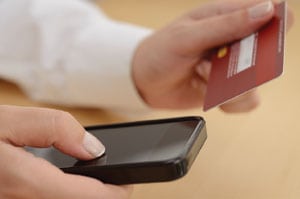 Predictions for the uptake of mobile payments by American consumers have been falling like the stock market in 2008, while global payments are zooming upward.
Predictions for the uptake of mobile payments by American consumers have been falling like the stock market in 2008, while global payments are zooming upward.
The latest blow to inflated U.S. expectations came from eMarketer. In October 2012, eMarketer predicted the market for proximity mobile payments would grow to $2.12 billion in 2013. At mid-year, the estimate has been cut in half, to $1 billion for proximity mobile payments. In recent weeks, we’ve also learned that consumers have been slow to adopt Google and Isis e-wallets.
The global picture, in contrast, is rosy. Gartner has predicted dramatic growth, with global transactions increasing 44% in 2013 to $235.4 billion.
So what’s happening? Growth in proximity payments has been hampered by the lack of standards and slow adoption of near field communications at POS terminals. NFC will account for only about 2% of total transaction value in 2013 and 5% of the total transaction value in 2017.
For the tap-and-pay crowd as well as online shoppers, Starbucks stands out as a winner. Paying with your smart phone at Starbucks is convenient, rewarding and builds on a great experience in the store.
For example, Starbucks accepts Google wallet at their POS as well as allows customers to pay online via Starbucks mobile app. Of course, Starbucks controls the entire process and integrates mobile tightly with the rest of the brand experience.
By contrast, Google Wallet and Isis face an uphill battle with consumers who are comfortable with their credit cards and need a compelling reason to switch.
The global outlook for mobile payment growth is far brighter, but the rocket fuel behind the growth of mobile payments worldwide isn’t tap-and-pay, and you don’t need the latest smart phone or NFC terminal at the point of sale.
By far the biggest driver of growth is mobile money transfers, which are projected to make up about 71% of total transaction values in 2013 and 69% in 2016. Most of those transactions are small and less expensive for consumers than a bank or credit card payment.
Most of the growth will come from Asia/Pacific and Africa. Asia/Pacific’s transaction value is expected to grow 38% in 2013 to reach $74 billion. By 2016, Gartner predicts that Asia-Pacific will overtake Africa to become the largest region by transaction value, reaching $165 billion.
Vodacom’s M-Pesa, the world’s leading mobile money network, is a case study in successful mobile payments. Through M-Pesa, millions of Africans transfer funds to other people and pay their bills using their mobile phones. It’s so successful that two-thirds of the Kenyan population—17.1 million customers — filter $13 billion through M-Pesa annually. Another 5 million Tanzanians use M-Pesa, too.
If you are a merchant, ask yourself: Can my customers pay me using money transfers? If the answer is no, you are missing out on the biggest chunk of the global market. Most North American merchants accept just a few payment methods, with cards and PayPal at the top of the list.
In fact, it’s not easy to get out into a broader, global market. Each region has its own flavors of payments, not to mention currency, language and cultural differences. I estimate that a truly global merchant handles more than 250 different payment types around the world. It’s no wonder that only the largest brands succeed on a global basis. A large merchant can invest on a region by region basis, but smaller merchants are left out of the global market, based on the sheer complexity of the challenge.
For this reason, I predict that the global game changers in mobile payments won’t be Google, Isis, or companies like Square that appeal to our desire for eye candy. The biggest potential growth will occur when merchants can accept more payment types worldwide, ranging from money transfers to regional payment providers.
I believe that payment platforms will play a crucial role in the growth of mobile payments worldwide. A payment platform can perform the essential task of handling dozens of payment types, languages and currencies, automating the payment process.
Merchants will be able to take payments as easily from Kenya as they do now from Silicon Valley. Instead of guessing at whether to support Google Wallet, Isis or any number of payment methods, the merchant will expect the payment platform to handle the complexity automatically.
Payment platforms can level the playing field, also, allowing smaller merchants to accept a much broader variety of payment types and play in more markets worldwide.
Global reach with local payment methods – the two combined are a recipe for returning the sizzle to mobile payments growth.
Ralph Dangelmeier is CEO of global payment service provider BlueSnap.